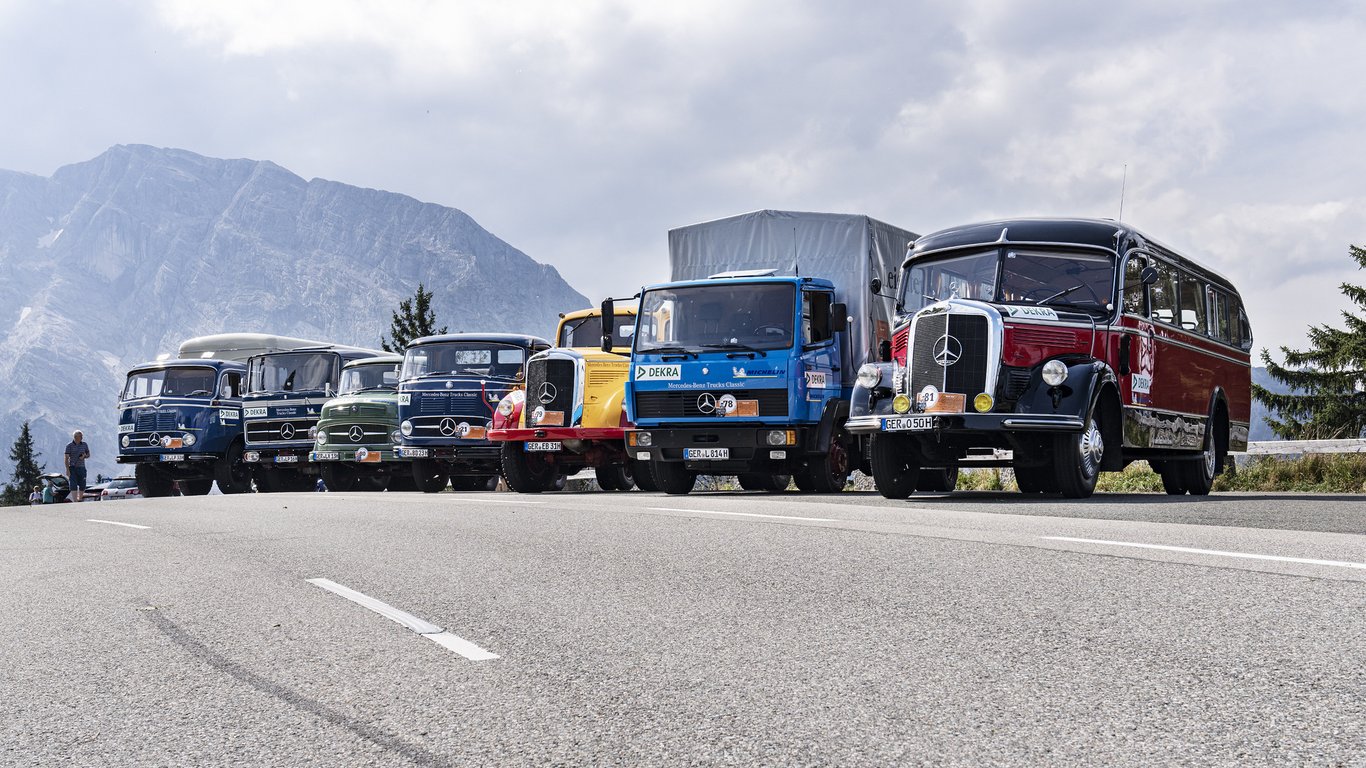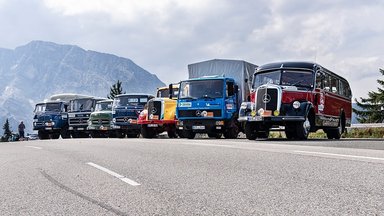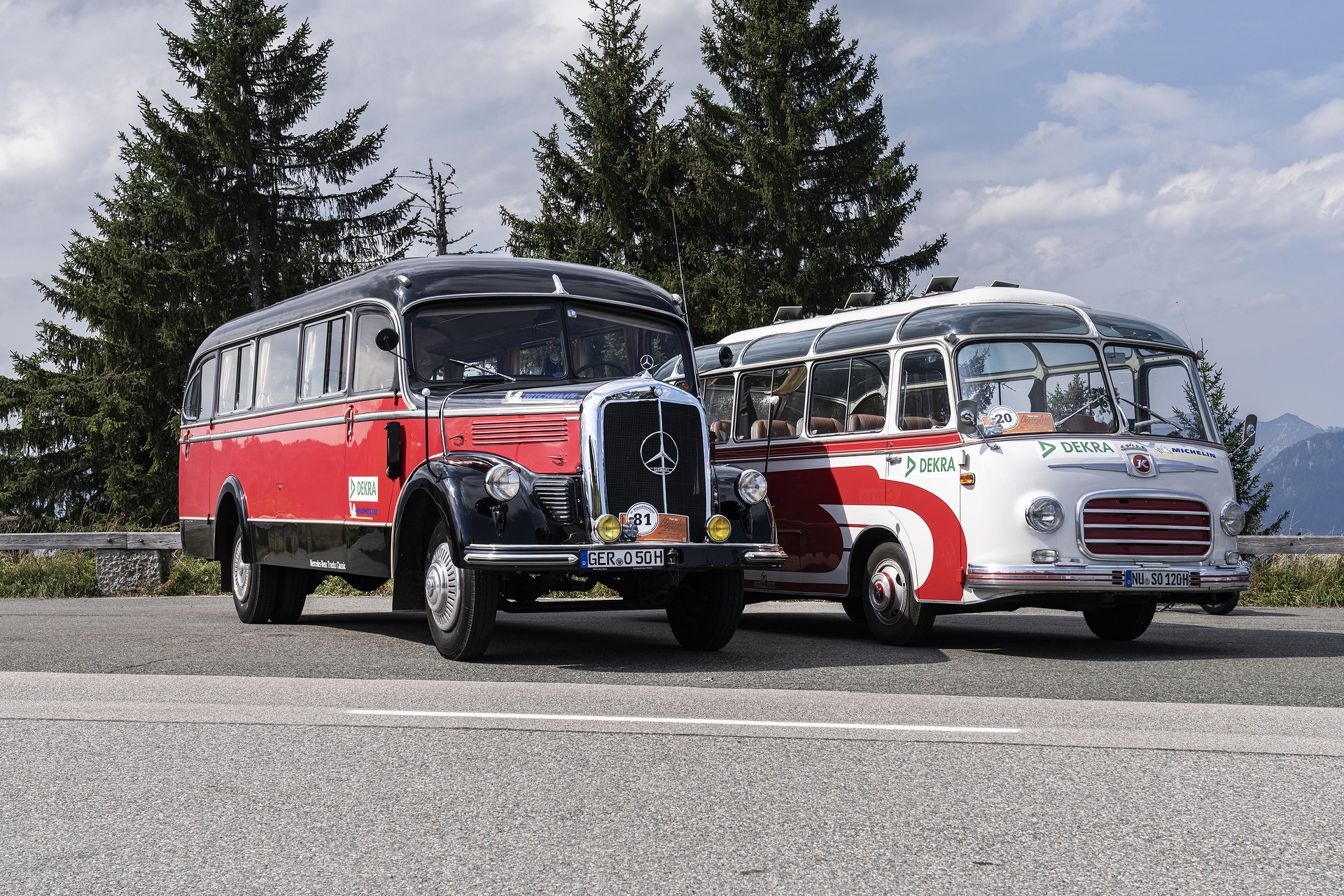
Anniversary tour: Eight truck and bus legends from Mercedes-Benz and Setra at the 20th Germany tour for historic commercial vehicles
Download

Anniversary tour: Eight truck and bus legends from Mercedes-Benz and Setra at the 20th Germany tour for historic commercial vehicles
Public favorites with a snout: Mercedes LAK 315 and O 3500 conventional-design trucks A bizarre rarity: Mercedes-Benz LP 333 "Millipede" Promise of luxury: Mercedes-Benz LP 323 and LP 1620 with Pullman cab Legendary conventional-design truck with short hood: Mercedes-Benz L 1113 A modern classic: Lightweight class with clear-cut design Trend-setting in bus engineering: Setra S6 You're welcome to marvel: Tour stopped at…
- Public favorites with a snout: Mercedes LAK 315 and O 3500 conventional-design trucks
- A bizarre rarity: Mercedes-Benz LP 333 "Millipede"
- Promise of luxury: Mercedes-Benz LP 323 and LP 1620 with Pullman cab
- Legendary conventional-design truck with short hood: Mercedes-Benz L 1113
- A modern classic: Lightweight class with clear-cut design
- Trend-setting in bus engineering: Setra S6
- You're welcome to marvel: Tour stopped at six locations
Leinfelden/Wörth am Rhein/Neu-Ulm – With the “Tour of the Legends”, the organizers, Stuttgart-based ETM Verlag in cooperation with the freight forwarder Fehrenkötter, celebrated the 20th Germany tour for historic commercial vehicles. They paid tribute to the creators and supporters of the tour, such as founder and freight forwarder Robert Fehrenkötter, as well as the first commercial vehicle collectors such as August Alborn, Emil Bölling and Hans Witteler, as well as the automotive legends. After all, since the invention of buses and trucks, they have ensured the mobility of people and goods and thus also the prosperity of society.
Mercedes-Benz LAK 315 and O 3500: Trucks with conventionally designed cab and long hood of the Miracle on the Rhine era
Mercedes-Benz trucks and buses as well as Setra buses are among the classics in 125 years of commercial vehicle history. Eight of the rolling cultural monuments from Daimler Truck's classic collections took part in the Germany tour this year – including two of the trucks with conventional cab design popular with the public from the Miracle on the Rhine era, during which they helped to rebuild and reignite the desire to travel.
The 14.7-ton Mercedes-Benz LAK 315 was built between 1953 and 1958 at the Gaggenau plant and was identical in design to its predecessor, the L 6600, which Mercedes had been producing there since 1950. The all-wheel drive dump truck for the Germany tour dates back to 1955, came to Mercedes-Benz Trucks Classic from the fleet of gravel and sand specialist Emil Bölling – one of the first supporters of the Germany tour – and is in a lovingly restored, original condition. It goes without saying that this vehicle had to be on the tour in the anniversary year.
Buses such as the Mercedes-Benz O 3500 from 1950 also proudly bore the conventional design with the long hood at this time, as the completely newly developed bus shared the technical basis with the L 3500 truck series. In 1949, the bus was devised in Sindelfingen, before being produced as the first vehicle at the Mannheim plant from 1951. By the end of production in 1955, it had sold more than 6,000 units, making it the most successful bus of its time. Originally, Daimler-Benz delivered the O 3500 of the Germany tour to the police in East Berlin, who handed the vehicle over to regular service routes in the city of Potsdam after five years. It was in service there until 1975, when an enthusiast bought and restored the vehicle. This spring, Daimler Buses once again technically overhauled the O 3500 in Neu-Ulm.
Mercedes-Benz LP 333: so-called Millipede establishes a cab-over-engine truck
Another public attraction is the Mercedes-Benz LP 333. Its friends lovingly refer to the three-axle truck as the "Millipede". With two steered front axles, the veteran is a highlight of every classic event. Daimler-Benz AG, the name under which the company was trading at the time, responded to the so-called Seebohm laws with this design, which seems unconventional from today's perspective. At the end of the fifties, German Federal Minister of Transport Hans-Christoph Seebohm limited the permissible gross mass of trucks and only three-axle vehicles were allowed to move a total of 16 tons as solo vehicles. With a dead weight of 8.3 tons and a payload of nine tons, the LP 333 remained under the 16-ton regulation for three-axle vehicles. When the laws were revised shortly afterwards and two-axle vehicles were allowed to weigh 16 tons again, the LP 333 disappeared from the range. Until 1961, Daimler-Benz only built 1,833 of these vehicles. Today, only a few roadworthy examples are still on the road. However, the short production time was sufficient to help the cab-over-engine concept break through.
Mercedes-Benz LP 323: 7.4-ton vehicle with Pullman cab
The Mercedes-Benz LP 323, launched a year later, also bears witness to this. As with the LP 333, the “P” in the model designation also stands for Pullman. The name was derived from the American luxury railway cars. The compact design of the 7.4-ton cab-over-engine vehicle enabled a longer platform with a shorter wheelbase, which benefited the vehicle's payload and maneuverability. The vehicle served the Germany tour faithfully until 1991 – most recently at a metal goods store. The LP 323 was then restored over twelve years of detailed work at the Wörth plant.
Mercedes-Benz LP 1620: Advent calendar on wheels
In 1963, Mercedes-Benz launched a vehicle with a completely new cab design for heavy-duty trucks. Large windows and an angular design were the hallmarks and, at the same time, offered unprecedented all-around visibility. As the cab was higher than in the predecessor, the engine tunnel in the interior was significantly lower and now made it possible to climb through to the front passenger side. It goes without saying that the “P” also had to be in the model designation here. The vehicle also boasted a number of technical innovations. The new OM 346 diesel direct injection engine significantly reduced fuel consumption compared to its predecessor and the new dual-circuit/dual-line brake system significantly increased safety. Since the cab was not tiltable in this model series, the corresponding major assemblies were accessed through maintenance flaps on the front of the cab and on both sides. That's why the vehicle was soon given its nickname of “Advent Calendar”. Our vehicle saw the light of day in 1964 and is still in a great, restored condition with the original engine and transmission after more than 2 million kilometers.
Mercedes-Benz L 1113: Unmistakable classic and endurance runner
The Mercedes-Benz L 1113 was also a result of Seebohm's laws, but in contrast to the LP 333 it was a perennial favorite. Initially, Daimler-Benz presented the medium-duty conventionally designed truck featuring a short hood with headlamps reminiscent of rolling eyes as the L 322 in 1959 and produced it from 1963 under the model designation L 1113 for a total of 25 years. At the time of the rebranding, it was also equipped with the OM 352 direct injection diesel engine – also a bestseller, which was the first choice for Mercedes-Benz medium-duty trucks for decades. The vehicle for the Germany tour was first registered in 1966 and ran for 20 years at a fruit seller before it became part of the Mercedes-Benz Trucks Classic collection.
Setra S6: Timelessly beautiful club bus, as good as new and technically sophisticated
The Setra S6, in turn, is a popular choice for passenger transport. With a length of 6.7 meters, the timelessly beautiful red and white-painted club bus from the brand's classic collection is the smallest Setra ever built. From roof edge glazing to independent wheel suspension with progressive rubber torsion suspension on both axles, the compact bus from 1962 is the epitome of contemporary, comfortable travel for up to 25 passengers. With its self-supporting body and rear engine from Henschel, it offered the same technical basic framework as the larger Setra models. The specimen for the Germany tour originally belonged to the Ulm University of Applied Sciences. It used the bus for measurements and in 1972 exchanged it for another vehicle in mint condition and with just 25,000 kilometers on the clock.
Mercedes-Benz 814: Light Class shows clear edge
In 1984, “Light Class” trucks replaced the LP models, which had dominated its segment for almost 20 years, and marked the beginning of modern truck design with a comprehensive selection of models from semitrailer trucks to chassis and dump truck, as well as a finely graduated range of weight and engine variants. The design of the Light Class with its clear, functional edge replaced the round, playful shapes of the preceding model series. This is demonstrated by the participating Mercedes-Benz 814, with a body bearing the advertising slogan for the market launch: “Lighter in top form”.
Cheers for 1,200 kilometers: Route ran from Sauerland to Bavaria
Despite their age, all eight vehicles are in impressive form. This is also an advantage. Just like on the first Germany tour in 1987, the 20th edition also ran from the west to the south of Germany. From Brilon in the Sauerland region, where the convoy formed at Mercedes-Benz dealer Witteler, the journey went to Fladungen in Lower Franconia and on to Upper Bavaria via Kirchberg an der Jagd. The convoy initially stopped there at Forstinning. The route continued across the Austrian border to Lengau in Innviertel (Upper Austria) and via Ainring in Berchtesgadener Land to Wörgl in Tyrol. After a total of six stages and more than 1,200 kilometers, the “Tour of the Legends” concluded in Dachau, very close to the Bavarian state capital Munich.
Article assets

Anniversary tour: Eight truck and bus legends from Mercedes-Benz and Setra at the 20th Germany tour for historic commercial vehicles

Anniversary tour: Eight truck and bus legends from Mercedes-Benz and Setra at the 20th Germany tour for historic commercial vehicles

Anniversary tour: Eight truck and bus legends from Mercedes-Benz and Setra at the 20th Germany tour for historic commercial vehicles

Anniversary tour: Eight truck and bus legends from Mercedes-Benz and Setra at the 20th Germany tour for historic commercial vehicles

Anniversary tour: Eight truck and bus legends from Mercedes-Benz and Setra at the 20th Germany tour for historic commercial vehicles

Anniversary tour: Eight truck and bus legends from Mercedes-Benz and Setra at the 20th Germany tour for historic commercial vehicles

Anniversary tour: Eight truck and bus legends from Mercedes-Benz and Setra at the 20th Germany tour for historic commercial vehicles

Anniversary tour: Eight truck and bus legends from Mercedes-Benz and Setra at the 20th Germany tour for historic commercial vehicles

Anniversary tour: Eight truck and bus legends from Mercedes-Benz and Setra at the 20th Germany tour for historic commercial vehicles

Anniversary tour: Eight truck and bus legends from Mercedes-Benz and Setra at the 20th Germany tour for historic commercial vehicles

Anniversary tour: Eight truck and bus legends from Mercedes-Benz and Setra at the 20th Germany tour for historic commercial vehicles

Anniversary tour: Eight truck and bus legends from Mercedes-Benz and Setra at the 20th Germany tour for historic commercial vehicles

Anniversary tour: Eight truck and bus legends from Mercedes-Benz and Setra at the 20th Germany tour for historic commercial vehicles

Anniversary tour: Eight truck and bus legends from Mercedes-Benz and Setra at the 20th Germany tour for historic commercial vehicles

Anniversary tour: Eight truck and bus legends from Mercedes-Benz and Setra at the 20th Germany tour for historic commercial vehicles

Anniversary tour: Eight truck and bus legends from Mercedes-Benz and Setra at the 20th Germany tour for historic commercial vehicles

Anniversary tour: Eight truck and bus legends from Mercedes-Benz and Setra at the 20th Germany tour for historic commercial vehicles

Anniversary tour: Eight truck and bus legends from Mercedes-Benz and Setra at the 20th Germany tour for historic commercial vehicles

Anniversary tour: Eight truck and bus legends from Mercedes-Benz and Setra at the 20th Germany tour for historic commercial vehicles

Anniversary tour: Eight truck and bus legends from Mercedes-Benz and Setra at the 20th Germany tour for historic commercial vehicles

Anniversary tour: Eight truck and bus legends from Mercedes-Benz and Setra at the 20th Germany tour for historic commercial vehicles

Anniversary tour: Eight truck and bus legends from Mercedes-Benz and Setra at the 20th Germany tour for historic commercial vehicles

Anniversary tour: Eight truck and bus legends from Mercedes-Benz and Setra at the 20th Germany tour for historic commercial vehicles

Anniversary tour: Eight truck and bus legends from Mercedes-Benz and Setra at the 20th Germany tour for historic commercial vehicles

Anniversary tour: Eight truck and bus legends from Mercedes-Benz and Setra at the 20th Germany tour for historic commercial vehicles

Anniversary tour: Eight truck and bus legends from Mercedes-Benz and Setra at the 20th Germany tour for historic commercial vehicles

Anniversary tour: Eight truck and bus legends from Mercedes-Benz and Setra at the 20th Germany tour for historic commercial vehicles

Anniversary tour: Eight truck and bus legends from Mercedes-Benz and Setra at the 20th Germany tour for historic commercial vehicles

Anniversary tour: Eight truck and bus legends from Mercedes-Benz and Setra at the 20th Germany tour for historic commercial vehicles

Carola Pfeifle
Spokesperson Product Communications Mercedes-Benz Trucks
carola.pfeifle@daimlertruck.com
+49 160 8612423

Udo Sürig
Spokesperson Setra Product & Service Communications
udo.suerig@daimlertruck.com
+49 160 86 16 312































